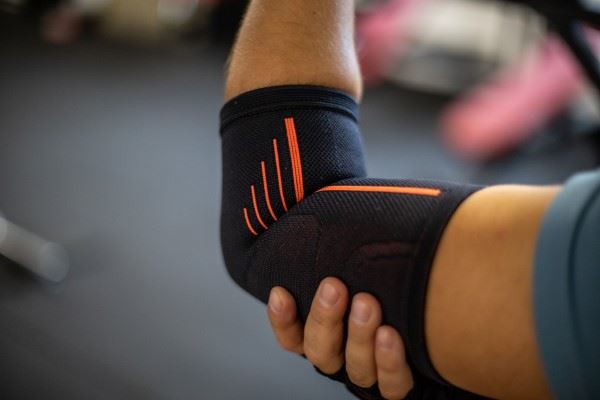-
Home
-
Elbow Braces for Tendonitis: What You Need to Know
Elbow Braces for Tendonitis: What You Need to Know
February 29, 2024
 Tendonitis of the elbow, commonly known as tennis or golfer's elbow, is caused by repetitive stress on the tendons that attach to the lateral or medial epicondyle of the elbow. Fortunately, there are non-invasive treatment options available to help alleviate the pain and promote healing. One of these options is wearing an elbow brace. In this article, we will explore how an elbow brace can help relieve tendonitis pain and answer some common questions about its use.
Tendonitis of the elbow, commonly known as tennis or golfer's elbow, is caused by repetitive stress on the tendons that attach to the lateral or medial epicondyle of the elbow. Fortunately, there are non-invasive treatment options available to help alleviate the pain and promote healing. One of these options is wearing an elbow brace. In this article, we will explore how an elbow brace can help relieve tendonitis pain and answer some common questions about its use.
How Do Elbow Braces Work?
Elbow braces are designed to apply pressure to the affected area, reducing strain on the tendons and muscles around the joint. This can help relieve pain and inflammation caused by tendonitis. There are different types of elbow braces available, including compression sleeves, straps, and full-arm braces. Your doctor or physical therapist can recommend which type of brace is best suited for your specific condition.
Do Elbow Braces Help with Tendonitis?
Yes—wearing an elbow brace can help relieve the pain associated with tendonitis of the elbow. The brace works by providing compression and support to the affected area, which helps reduce inflammation, increase blood flow, and promote healing. Additionally, it helps limit movement in the affected arm, which reduces further irritation to the tendons.
Types of Elbow Braces for Tendonitis
The most popular brace options for managing tennis elbow and medial epicondylitis are elbow straps and sleeves. Elbow straps are worn just below the elbow joint and provide targeted compression to the tendons in the forearm. Elbow sleeves, on the other hand, are worn over the entire elbow joint and provide more general compression and support.
Elbow straps are typically made of a comfortable and breathable material, such as neoprene, and are designed to be worn just below the elbow joint. They work by applying pressure to the tendons in the forearm, which can help reduce strain on the injured area.
Elbow sleeves are another commonly used option for managing elbow tendonitis. These sleeves are worn over the entire elbow joint and provide compression and support to the entire area. Like elbow straps, elbow sleeves are typically made of a breathable material and are comfortable to wear for extended periods.
Choosing the Right Brace
When selecting an elbow brace for tendonitis, it is important to consider the severity of the condition and your individual needs. For mild to moderate cases of tendonitis, a simple elbow strap may be sufficient to provide relief. However, for more severe cases or for individuals who engage in activities that place increased stress on the elbow joint, a more supportive elbow sleeve may be necessary.
It is also important to ensure that the brace fits properly and is comfortable to wear. A brace that is too tight can restrict blood flow and cause discomfort, while a brace that is too loose may not provide adequate support. It may be helpful to try on several different braces to find the one that feels comfortable and provides the right level of support.
What is the Best Treatment for Tendonitis of the Elbow?
Aside from wearing an elbow brace, other treatment options for tendonitis of the elbow include rest, ice, and physical therapy exercises. Resting your arm allows time for your tendons to heal, while ice therapy can reduce inflammation and swelling. A physical therapist can help you perform specific exercises to strengthen the muscles around the elbow, improve flexibility, and help reduce pain and inflammation.
Is a Compression Sleeve Good for Elbow Tendonitis?
Yes—compression sleeves can be beneficial for elbow tendonitis. They provide gentle compression to the elbow joint, which can help reduce swelling and improve blood flow. Compression sleeves also provide mild support, helping reduce pain and improve function.
How Do I Properly Wear an Elbow Brace?
If you are using an elbow strap, position it just below the elbow joint and adjust it to provide a comfortable level of compression. If you are using an elbow sleeve, slide it over your forearm and elbow joint, making sure it fits snugly but not too tight.
It is important to follow the manufacturer's instructions for wearing and caring for your elbow brace. If you experience any discomfort or irritation while wearing the brace, remove it and consult with a healthcare professional.
Whether you are dealing with tennis elbow, medial epicondylitis, or another form of elbow tendonitis, a brace can help reduce pain, promote healing, and improve function. Before beginning any type of treatment plan, however, it is important to consult with a healthcare professional. By choosing the right brace and using it properly, you can effectively manage your symptoms and get back to the activities you love.